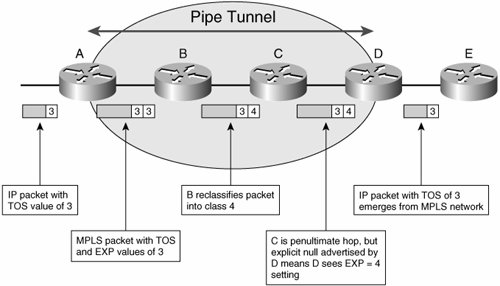MPLS QoSUniform Tunnel and Pipe Modes
| In uniform tunnel mode, any changes to a packet's differentiated services code points (DSCPs) are permanent, as shown in Figure B-1 and discussed in the following list:
Figure B-1. MPLS Uniform Tunnel Mode Pipe tunnel mode differs from uniform tunnels in two ways. First, changes to EXP are not copied to the internal DSCP. Second, the egress provider edge (PE) classification is done using the MPLS EXP value. Figure B-2 shows how pipe tunnel mode works, as described in the following steps:
Figure B-2. MPLS Pipe Tunnel Mode The pipe tunnel mode has a subtlety. LSR D ordinarily does not see the EXP values because of penultimate hop popping (PHP) on LSR C. However, because of the semantics of the pipe tunnel, LSR D needs EXP information so that it can apply the correct PHB for the packet. To reconcile this conflicting state of affairs, the egress LSR uses a concept called explicit null, which causes the penultimate-hop router to no longer pop the outer label when forwarding frames to its upstream neighbor. Explicit null labels are not needed if the egress LSR is going to receive a label anyway (for example, if there are two labels on the stack, even if the outer one is popped, the PE always receives a labeled packet). A variation of the pipe tunnel mode is called short pipe mode; in this mode, the egress PE uses the packet's IP DSCP to apply per-hop behavior (PHB). |
EAN: 2147483647
Pages: 128